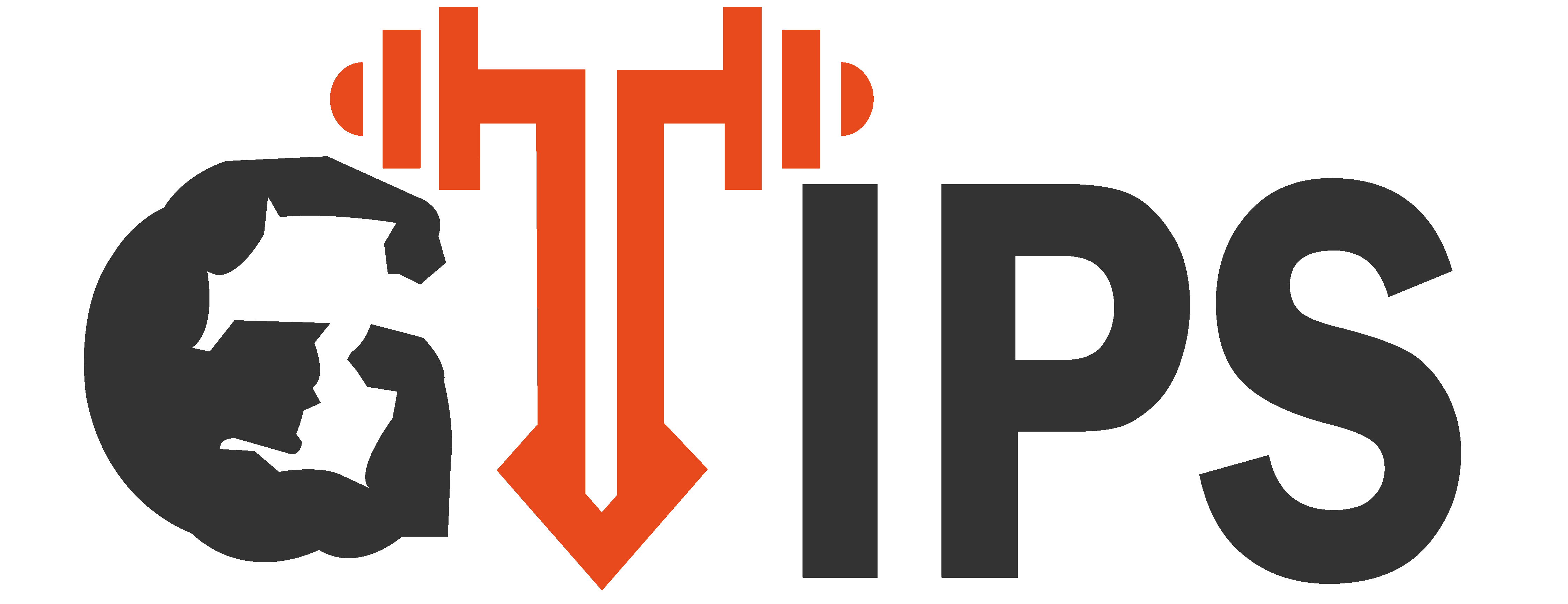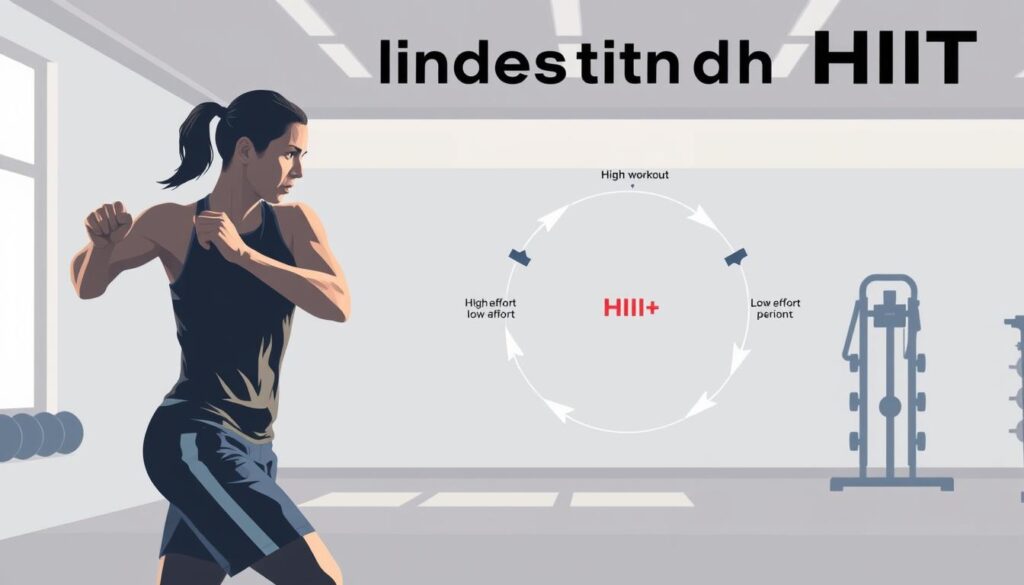Ever thought about losing weight faster than usual? High-Intensity Interval Training (HIIT) is a quick way to do just that. It combines intense exercise with rest periods. This makes HIIT workouts fun and effective for losing weight.
Studies prove HIIT can cut body fat and boost health in short workouts. It burns calories as much as long cardio sessions. This method keeps your body burning calories long after you stop exercising. It’s perfect for those with busy lives who want to lose weight and build muscle.
Key Takeaways
- HIIT workouts can deliver the same calorie burn as traditional workouts in a fraction of the time.
- Incorporating strength training with HIIT helps preserve muscle mass and boosts metabolism.
- HIIT can activate EPOC, allowing the body to burn calories for up to 24 hours after the session.
- Regular HIIT sessions, performed 2-3 times a week, can help you avoid overtraining.
- Effective HIIT routines often include exercises like burpees, jump squats, and mountain climbers.
Understanding High-Intensity Interval Training (HIIT)
HIIT is a unique way to exercise. It mixes intense effort with rest periods. This method burns a lot of calories in a short time. HIIT workouts last from 10 to 30 minutes, perfect for those short on time.
Research shows HIIT burns 25-30% more calories than regular exercise. It also keeps your metabolism high for hours after. This helps in losing body fat and reducing waist size, great for those who are overweight.
HIIT includes activities like cycling, sprinting, and bodyweight exercises. It boosts both aerobic and anaerobic performance. To get the best results, choose exercises you like and rest well. Keep the intense parts under 30 seconds to avoid getting too tired.
HIIT also has mental benefits. It keeps workouts interesting and varied. It’s good for many people, including those with diabetes, high blood pressure, or heart disease. Always talk to a doctor before starting HIIT, even more so if you’re new to exercise or have health issues.
Benefits of HIIT Workouts for Weight Loss
HIIT workouts offer more than just exercise. They are great for those looking to lose weight. These workouts burn a lot of calories during and after the session. This is because of the afterburn effect, or excess post-exercise oxygen consumption (EPOC).
Studies show that HIIT can help you lose about 5.7 kg on average. This makes it a powerful tool for managing weight.
HIIT is also very efficient. A typical session lasts about 35 minutes. This is much shorter than other types of workouts, which can last up to 46.5 minutes. This shorter time makes it easier for people with busy lives to fit into their schedules.
HIIT not only helps you lose weight but also improves your overall health. It can lower your body mass index (BMI) by about 1.9 kg/m². This means you can lose body fat while keeping your muscle mass.
HIIT also boosts your heart health. It increases your VO2peak, which is a measure of your cardio fitness. This is important for keeping your heart healthy and supporting weight loss.
As you get better at HIIT, your body becomes more efficient at burning fat. This makes it easier to lose weight and improves your metabolism.
| Workout Type | Mean Weight Loss (kg) | Mean Duration (minutes) | BMI Reduction (kg/m²) | VO2peak Increase (mL) |
|---|---|---|---|---|
| HIIT | -5.7 | 35.0 | -1.9 | 461.6 |
| MICT | -6.0 | 46.5 | -2.1 | 170.5 |
In conclusion, HIIT workouts are a great way to lose weight and get fit. They are efficient and effective. Try HIIT to see the benefits for yourself.
How HIIT Boosts Metabolism and Burns Calories
High-Intensity Interval Training (HIIT) is a great way to boost your metabolism. It only takes 30 minutes to do a workout. This makes it a quick and effective way to burn fat.
HIIT burns 25-30% more calories than other exercises for the same time. This is why it’s so good for losing weight.
HIIT works by causing the afterburn effect, or excess post-exercise oxygen consumption (EPOC). This means your body keeps burning calories even after you stop exercising. Studies show you can burn 6% to 15% more calories after a HIIT session.
For example, if a workout burns 300 calories, you might burn an extra 18 to 45 calories after. This is because your body keeps working to recover.
HIIT also boosts human growth hormone (HGH) production by up to 450%. This hormone helps with cell regeneration and keeps your metabolism healthy. Plus, HIIT helps you lose fat and keep your muscle mass. This means you burn more calories, even when you’re not exercising.
How long the afterburn effect lasts depends on your weight, fitness level, and muscle composition. It’s not true that you burn calories for 24 hours after HIIT. It usually lasts a few hours.
The increase in metabolic rate after HIIT comes from higher levels of epinephrine and HGH. These hormones help reduce fat and make you leaner. HIIT is a powerful way to boost your metabolism and lose weight through intense workouts.
HIIT Workouts for Weight Loss: Effective Techniques
Using the right techniques is key to losing weight with High-Intensity Interval Training (HIIT). Knowing about the afterburn effect, or EPOC, is important. It helps your body keep burning calories even after you stop working out. This makes HIIT a great way to control your weight.
Maximizing the Afterburn Effect (EPOC)
HIIT workouts are designed to boost the afterburn effect. They mix short bursts of hard exercise with brief breaks. This keeps your metabolism high, burning more calories during and after your workout.
HIIT combines intense cardio with strength exercises. This makes it a powerful tool for losing weight.
Incorporating Strength Training into HIIT
Adding strength training to HIIT makes workouts more effective and helps keep muscle. You can use bodyweight exercises or resistance bands. This way, you can do both cardio and strength training in one session.
For example, a 6-week HIIT 100s program focuses on getting better and more intense. It’s great for burning fat and building lean muscle. For more on HIIT routines, check out this link.
Best HIIT Workouts for Quick Results
For quick results, the best HIIT workouts use high-intensity intervals and rest periods. You can do exercises like burpees, high knees, and mountain climbers. Each exercise lasts 20 to 40 seconds, followed by a rest period to maximize effort.
Quick HIIT workouts are great for those with little time. For example, start with 20 seconds of sprinting, then rest for 60 seconds. This boosts your heart health and helps burn fat.
Adding strength moves like dumbbell thrusters or kettlebell swings can boost your results. These exercises work many muscles and fit well with cardio intervals. A balanced workout mixes strength and endurance exercises for better weight loss.
Start your HIIT circuit with bodyweight exercises that need no equipment. HIIT routines can be adjusted for any fitness level, allowing for more intensity as you get better. Always warm up and cool down to avoid injuries and help your body recover.
Guidelines for Starting HIIT Safely
Starting a High-Intensity Interval Training (HIIT) program needs careful preparation. This ensures safety and effectiveness. Here are key guidelines for a safe start into HIIT workouts.
Importance of Proper Warm-Up
A good warm-up for HIIT is essential before starting. It lasts about 5-10 minutes and gets your muscles and joints ready. It also helps you perform better during the workout.
Dynamic stretches or light aerobic exercises are great for this. Arm circles, leg swings, and jogging in place are good examples. They help raise your heart rate and improve blood flow.
Hydration and Nutrition Tips
Drinking enough water is critical for HIIT workouts. It helps you perform better and recover faster. Eating a balanced meal with carbs and protein before HIIT is also important. It fuels your body for the workout.
After the workout, eating right is key for muscle repair. This is why recovery nutrition is a must. For more tips, check out these home workout plans. They offer guidance on nutrition and HIIT.
Creating an Effective Weekly HIIT Schedule
Creating a weekly HIIT plan is key for lasting weight management. Aim for 2-3 HIIT sessions a week, along with strength training. This mix helps keep muscles strong and boosts fitness.
Try a HIIT routine that fits into your daily life. Each workout can be as short as 10 minutes but packs big health benefits. Switching between intense exercise and rest keeps your heart rate up, burning calories.
Do your HIIT workouts on alternate days. On rest days, do steady-state cardio like walking or biking. This balance helps you recover while keeping your training consistent.
For the best weekly HIIT plan, add lighter activities for recovery. Try jumping jacks, burpees, and mountain climbers, adjusting them for your fitness level. This way, you can enjoy your workouts safely and effectively.
Common HIIT Exercises for Weight Loss
Adding common HIIT exercises to your workout can really help with weight loss. Burpees, jump squats, and mountain climbers are top choices. They burn calories and offer unique benefits.
Burpees
Burpees are great for losing weight because they’re intense and work your whole body. They boost your heart health and build muscle. Doing burpees is a smart move for any HIIT routine.
Jump Squats
Jump squats are excellent for strengthening your legs and burning fat. They’re explosive and raise your heart rate, burning more calories. Jump squats are a great way to challenge your muscles and improve endurance.
Mountain Climbers
Mountain climbers are great for your core and endurance. They’re easy to do anywhere and burn calories. Adding mountain climbers to your HIIT routine boosts your core strength and keeps your heart rate up.
Mixing these exercises into different circuits can make your workouts more effective. Adjusting the intensity and intervals helps fit the workout to your level. Regularly doing burpees, jump squats, and mountain climbers will help you lose weight and get fitter.
Conclusion
HIIT workouts are a great way to lose weight and get fit. They mix short, intense exercises with rest periods. This combo burns a lot of calories and keeps muscles strong, all in a short time.
Studies show HIIT burns 36.34% more calories than steady-state workouts. This makes it perfect for those with busy lives. It’s a quick way to get fit.
Adding HIIT to your routine helps manage weight and boosts heart health. Even obese people and seniors see weight loss in just 12 weeks. This shows HIIT works for everyone.
Regular HIIT practice leads to better body shape and more energy. It’s a powerful tool for weight management. HIIT benefits for weight management are clear and noticeable.
HIIT can change your weight loss journey. It’s great for cutting fat and improving fitness. To get the most out of HIIT, remember to warm up, do intense intervals, and rest well.
FAQ
What are HIIT workouts?
HIIT workouts, or High-Intensity Interval Training, are short, intense activities followed by rest. They burn lots of calories and help lose fat quickly.
How do HIIT workouts contribute to weight loss?
HIIT workouts burn a lot of calories during and after exercise. This is called the afterburn effect. It helps you lose weight.
How often should I do HIIT workouts for optimal weight loss?
For best results, do 2-3 HIIT sessions a week. Mix them with strength training. Make sure to rest well to get the most benefits.
What types of exercises can I include in my HIIT routine?
Good HIIT exercises include burpees, high knees, and jump squats. Mountain climbers are also great. They raise your heart rate and work many muscles.
Is it necessary to warm up before starting a HIIT workout?
Yes, warming up for 5-10 minutes is key. It gets your body ready, lowers injury risk, and boosts your workout performance.
Can HIIT workouts enhance my metabolic rate?
Absolutely. HIIT workouts boost your metabolic rate. This means you burn more calories during and after exercise. They’re great for managing weight.
What should I eat before and after a HIIT workout?
Eat a balanced meal with carbs and protein before HIIT. It fuels your workout. After, focus on recovery food to help muscles heal and rebuild.
Are HIIT workouts suitable for beginners?
Yes, HIIT workouts can be adjusted for all fitness levels. Beginners should start with lower intensities and gradually increase.
How does HIIT compare to traditional steady-state cardio?
HIIT is more efficient than steady-state cardio. It burns 25-30% more calories in the same time. It also offers similar heart health benefits but faster.






